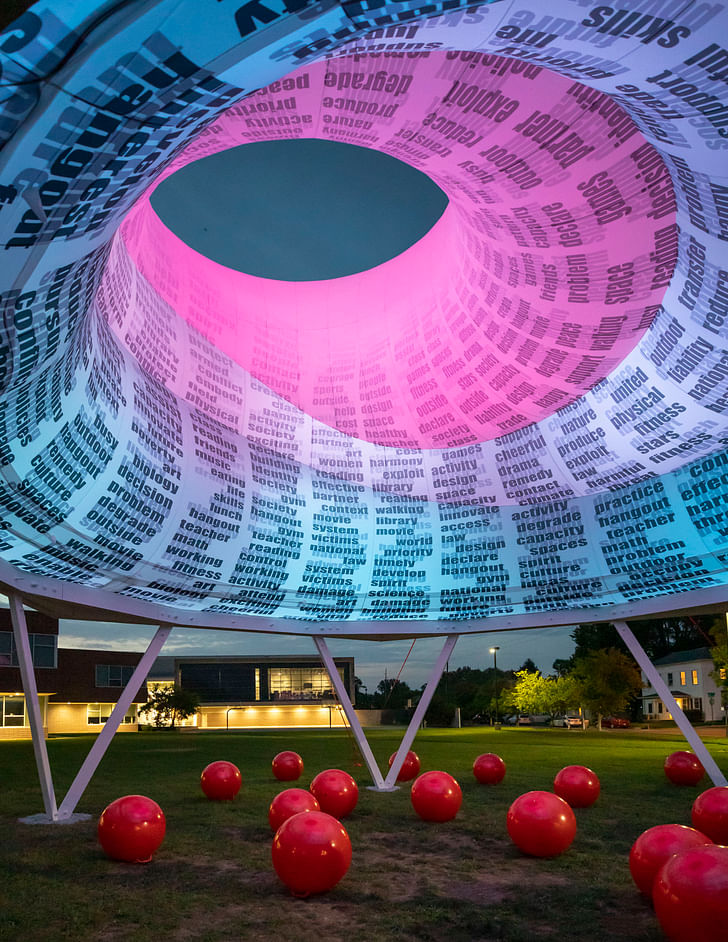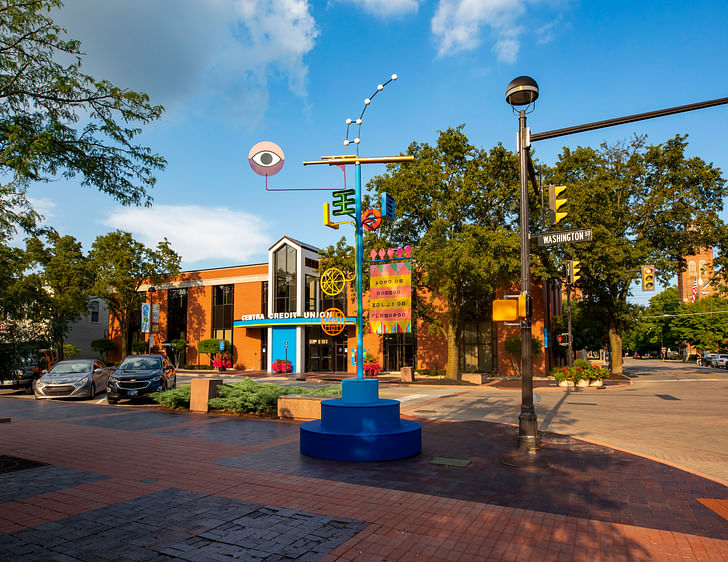

On Saturday, August 21, the city of Columbus, Indiana welcomed thirteen larger-than-life installations displayed throughout the area as part of Exhibit Columbus' 2021 Exhibition. The program explores art, architecture, design, and community in Columbus. While the city itself has garnered a reputation for being the home of notable modernist architecture, landscapes, and art, this year's curators and exhibition team unpack the meaning of civic life by showcasing a series of design projects aiming to identify and question: "What is the future of the middle city?"
The theme, New Middles: From Main Street to Megalopolis, What is the Future of the Middle City?, raises an important question about cities located within the center of the U.S., their ties to the past, present, and future through site-specific and site-responsive installations. According to the Exhibition's curators, Iker Gil and Mimi Zeiger, the design programming this year asks to "re-evaluate, refresh, and reframe" the city's architectural landscape, its connection to the community, and those from the outside looking in.
As Exhibit Columbus' official media sponsor, Archinect has provided coverage of the event's design presentations and exhibitions as well as in-depth conversations with its participants and curators. Our six-part conversation series, Next Up: Exhibit Columbus, showcases exclusive conversations with the curators and the recipients of The J. Irwin and Xenia S. Miller Prize. These conversations provide a curious look at the design processes and methodology behind each installation by asking how they respond, challenge, and activate the city and its people.
With the event's opening weekend completed, the Exhibit Columbus team provided Archinect with photos of the five J. Irwin and Xenia S. Miller Prize Installations currently on display. Accompanying each set of photographs are full recordings of its corresponding Next Up: Exhibit Columbus podcast interviews with the designers.
Installation Description: "Columbus Columbia Colombo Colón is an investigation of relationships. Christopher Columbus and the places named after him form a series of associations—of identity, property, and power. Designed to make the invisible visible, each vertical element represents a distinct place in the world. By navigating between each of the poles, visitors are invited to draw connections between different narratives and reflect on what is a collective story. Columbus, Indiana is not just a city, it is part of a larger complex of meaning. The persistence of these legacies is one that we all must grapple with."
Installation Description: "Cloudroom rethinks the physical space of education as teaching is reshaped by current and post-pandemic conditions. Created with input from students and staff at Central Middle School, the installation encourages new modes of learning and raises awareness about environmental challenges. The inflatable 'cloud' creates a shady microclimate for learning, playing, connecting, and interacting. The design evokes a dome and an oculus, reminding visitors and students of architectural features. Connected to environmental sensors, Cloudroom illustrates climatic conditions as the inflatable changes colors. Texts are drawn from the 1992 Rio Declaration on Environment and Development and from a survey of Central middle school students about their preoccupations, hopes, and dreams for the future."
Installation Description: "Midnight Palace is designed for occupants of the midnight city. It asks: What is a public space dedicated to those who live in the nocturnal hours? Columbus is a city of night owls: 39 percent of the population works in manufacturing, compared to 9 percent nationwide. Among this late-night group are second and third-shift workers, restaurant workers, truckers on I-65, parents of newborns, and residents with families overseas. A lattice-work of electrical conduit, Midnight Palace features a 'wall of light' inspired by Columbus’ streetscape: high-pressure sodium fixtures, LED light bulbs, and soffit lighting. Paying homage to the Columbus Drive-In, which closed in 1992. Screens feature community partner programming: from cricket matches to short films."
Installation Description: "Archival/Revival revisits transformative events held at the Cleo RogersMemorial Library, which opened in December 1969. An inaugural African art exhibit opened in January 1970 and was a part of 'Africa and Black and white America,' a two-month-long program developed by the HumanRelations Commission. The same year, the commission organized the 'Columbus Black Arts Festival.' All but one event was held at the library. Archival/Revival features sculptural and virtual elements representing key figures revived from the Columbus Indiana Architectural Archives. Visitors can explore historical documents and artworks and consider their relation to present and future realities. Visitors can use their mobile devices or tablets to interact with augmented reality (AR) artifacts."

Installation Description: "Alternative Instruments responds to Columbus as a site, place, history, but also a fiction. Suggesting how places and ideas are interconnected, the Washington Street installations draw parallels between Columbus' midcentury architecture, European Modernism, and utopian impulses of early American Settlements [...] Alternative Instruments uses civic design to create new narratives that point towards the future referencing Americana roadside signs, weathervanes, and measuring chains used by the British to claim territory. Quilts recall vernacular craft, with phrases from Utopia and written in Moore's fictional language."
For the city of Columbus, this "middle city" comes with an impressive history and its relationship to midcentury architecture. When asked about the goals of this year's exhibition theme and cycle, co-curator Iker Gil explained: "In terms of short-term and long-term, the question is how do we embrace a long timeline for the city? Of past, present, and future." He added that it was about taking this idea of the "middle city" and, over the next two years, to "foster conversations even after the exhibition cycle ends."
...we’re at a moment in time right now where that legacy holds but it also needs to be reevaluated, refreshed, and reframed" both for the people in Columbus and everybody else. — Mimi Zeiger
Curating partner Mimi Zeiger expanded on this by sharing: "Columbus has this legacy of midcentury modern design. J. Miller had an ambitious plan for how civic life for society might be life." She continued that "we’re at a moment in time right now where that legacy holds, but it also needs to be reevaluated, refreshed, and reframed" both for the people in Columbus and everybody else. This exploration, the work, and the designers involved help answer these questions and contribute to the Exhibition's quest for proactiveness and intention. Zeiger added that this year's theme was also for "the folks who are outside of Columbus looking in. Trying to figure out what is the meat of architecture given everything that’s going on right now."
...in terms of short-term and long-term, the question is how do we embrace a long timeline for the city? Of past, present, and future. — Iker Gil
While architecture discourse is often centered around larger metropolitan areas and cities, New Middles inquires how Columbus and the Midwest fit within the contemporary discourse about the built environment. During their discussion in our Archinect Next Up series interview, Gil explained that the theme was to explore the center of the nation and all the cities connected to the Mississippi watershed. He asked: "What is the future of this concept of a 'middle city' and thinking about that and its own conditions." Zeiger concluded by explaining: "It's a kind of recentering and thinking about what is the center of the U.S."
Stay tuned for more coverage of the Exhibit Columbus 2021 Exhibition.
Katherine is an LA-based writer and editor. She was Archinect's former Editorial Manager and Advertising Manager from 2018 – January 2024. During her time at Archinect, she's conducted and written 100+ interviews and specialty features with architects, designers, academics, and industry ...
1 Comment
It’s a really excellent batch of Miller prize winners this year. Ecosistema’s cloud is absolutely gorgeous. And Future Firm’s installation brings a little bit of Times Square to a sleepy Midwestern town. I love, love, love the notion of the night shift community; as architecture students back in the 90s we all know that weird feeling of finally going to bed when other people are just starting their day.
Block this user
Are you sure you want to block this user and hide all related comments throughout the site?
Archinect
This is your first comment on Archinect. Your comment will be visible once approved.